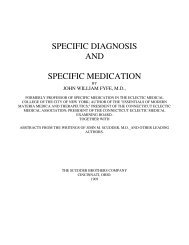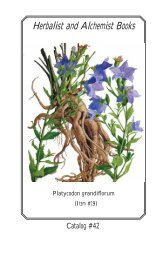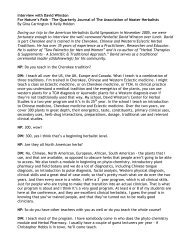MEDlCINAL PLANTS OF JAMAICA. PARTS 1 & 11.
MEDlCINAL PLANTS OF JAMAICA. PARTS 1 & 11.
MEDlCINAL PLANTS OF JAMAICA. PARTS 1 & 11.
Create successful ePaper yourself
Turn your PDF publications into a flip-book with our unique Google optimized e-Paper software.
MENISPERMACEAE<br />
A small tropical family distinguished by the presence of a number of characteristic alkaloids. including<br />
bebeerine. pelosine and cissampeline. Bitter principles are also present.<br />
CISSAMPELOS PAREIRA L. Velvet Leaf or Bush; False Pareira-brava.<br />
The shoots are used in Jamaica principally to make tea for colds. It was used in earlier times as a bitter<br />
tonic and for a diuretic effect, also for skin diseases. gonorrhoea. and as a plaster for sores. At one time this<br />
species was confused with the true Pareira brava derived from another member of the same family. It appears<br />
probable that it contains the same, or some of the same. alkaloids. An alkaloid (sepeerine) which, according to<br />
some authorities. is identical with the bebeerine of the true Pareira brava. is present and a second alkaloid<br />
(cissampeline) has also been recorded. The plant is used by some African tribes for purposes similar to those<br />
already mentioned. (2, 3, 5, 7, 8, 10, 14, 15, 27).<br />
MIMOSOIDEAE*<br />
MIMOSA PUDICA L. Shame Weed; Shut Weed; Shama; Shama Lady (many variations); Dead<br />
and Awake; Sensitive Plant.<br />
The root. particularly in combination with plants such as Desmodium sp. and Achyranthes indica is used<br />
to make tea for colds. It contains 10 per cent tannin. The plant is also said to be used for gonorrhoea and as a<br />
sedative. In Africa a leaf decoction is used for dysentery, as a tonic, and as an application for guinea worm. (2,<br />
7, 27).<br />
MORACEAE<br />
A family of some nine hundred temperate and tropical species with latex widely distributed. Cystoliths<br />
of calcium carbonate also occur in the leaves and bark. Rubber wax and resinous compounds are common in the<br />
latex, especially in Ficus species, and tannins are found especially in the bark. Only scattered representatives of<br />
groups of compound such as alkaloids and essential oils are present.<br />
ARTOCARPUS INCISA L. Breadfruit.<br />
The belief in the efficacy of a tea made from breadfruit leaves in cases of high blood pressure is<br />
widespread in Jamaica. (27).<br />
CECROPIA PELTATA L. Trumpet Tree: Snake Wood.<br />
The latex of this tree is said to contain an alkaloid, cowleyin. A decoction of the leaves is used for colds<br />
and is said to be a sovereign remedy for a sore throat and hoarseness. It is also said to be good for 'nerves'.<br />
Beckwith mentions the use of trumpet (no identification) in baths. (15, 27).<br />
MYRISTICACEAE<br />
A small tropical family of woody plants, many of which have oil cells in the leaves, stems and seeds.<br />
and in which tannin sacs are common. Essential oils and fats are found but alkaloids and glucosides are,<br />
apparently, absent.<br />
MYRISTICA FRAGRANS Houtt. Nutmeg.<br />
This plant produces the nutmeg and mace of commerce. It is official in the pharmacopoeias. The dried<br />
seed kernals of nutmeg contain 5 to 15 per cent of volatile oil and up to 40 per cent of fats. The volatile oil<br />
contains d-camphene, d-pinene, dipentene, d-borneol, I-terpineol, geraniol, safrole and a toxic substance<br />
myristicin. A saponin is also said to be present in nutmeg. Beckwith says that powdered nutmeg is given to<br />
women in labour. (3, 8, 10, 14, 27).<br />
*See also LEGUMINOSAE







